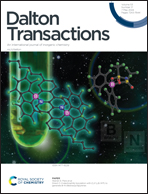Iridium(iii)-based minor groove binding complexes as DNA photocleavage agents†
Abstract
Transition metal complexes containing the qtpy ligand (2′:4,4′′:4′,4′′′-quaterpyridyl) are known to be DNA intercalators or minor groove binders. In this study, new tricationic iridium(III) complexes of qtpy are reported. Both [Ir(bpy)2(qtpy)]3+1 and [Ir(phen)2(qtpy)]3+2 display good water solubility as chloride salts. The complexes possess high-energy excited states, which are quenched in the presence of duplex DNA and even by the mononucleotides guanosine monophosphate and adenosine monophosphate. Further studies reveal that although the complexes bind to quadruplex DNA, they display a preference for duplex structures, which are bound with an order of magnitude higher affinities than their isostructural dicationic RuII-analogues. Detailed molecular dynamics simulations confirm that the complexes are groove binders through the insertion of, predominantly, the qtpy ligand into the minor groove. Photoirradiation of 1 in the presence of plasmid DNA confirms that this class of complexes can function as synthetic photonucleases by cleaving DNA.

- This article is part of the themed collection: Articles behind our 2024 journal covers


 Please wait while we load your content...
Please wait while we load your content...